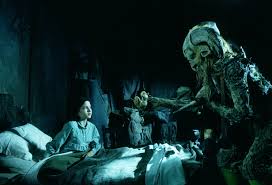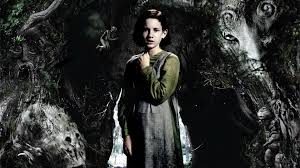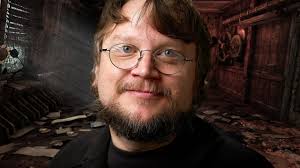 This essay is based on a presentation I gave at the Oregon Museum of Science and Industry on April 13, 2016, as part of OMSI’s “Reel Science” series in which a lecture precedes the showing of a popular movie. My lecture involved the science of lucid dreaming, and the film was Guillermo del Toro’s “Pan’s Labyrinth” (2006).
This essay is based on a presentation I gave at the Oregon Museum of Science and Industry on April 13, 2016, as part of OMSI’s “Reel Science” series in which a lecture precedes the showing of a popular movie. My lecture involved the science of lucid dreaming, and the film was Guillermo del Toro’s “Pan’s Labyrinth” (2006).
A simple definition of lucid dreaming is this: the experience of consciousness or self-awareness within the dream state. Sometimes it includes a greater sense of intentionality or control—the dreamer has some ability to change or alter what’s happening in the dream.
Here are some statistics about the frequency of lucid dreaming among the general population, drawn from the two-volume anthology Ryan Hurd and I edited in 2014, Lucid Dreaming: New Perspectives on Consciousness in Sleep.
- More than 50% of the population has had at least one dream of lucid awareness
- Gender: slightly higher frequencies for females
- Age: much higher frequencies (70%-80%) in early adulthood, then a drop-off over time
- Higher frequencies for religious “nones,” political liberals, and people living in Western US
- No major differences on other demographic variables
We also have some research on the content of lucid dreams, and what makes them distinctive from ordinary dreams. In general, lucid dreams are not radically different from ordinary dreams; they both share the same basic substrate of dreaming experience. In this sense lucid dreaming is an extension of what’s already going on in ordinary dreaming. We do not need to invoke a separate psychological system to explain what happens in lucid dreaming.
That being said, the few differences are illuminating. Lucid dreams have more references to:
- Awareness
- Effort
- Flying
- Fantastic beings
- Physical aggression
Lucid dreams have fewer references to:
- Colors
- Speech
- Family characters
- Friendly social interactions
These are tendencies, not absolutes, so they don’t apply to every individual experience. But they make sense in that lucidity often emerges during nightmares (physical aggression) or when the individual encounters something bizarre or anomalous (flying, fantastic beings), and the dreams often do lead away from the normal social world into strange, unfamiliar places.
The frequency of lucid dreaming is not set in stone. As several researchers have found, gaining conscious awareness in dreaming is an ability that may first appear spontaneously, but can also be trained like a cognitive skill, and guided with some degree of precision.
In the past few years a number of electronic devices have been invented and marketed as tools for lucid dream induction, with several more such devices in development.
These devices represent high-intensity and rather aggressive approaches to lucid dreaming. They can get results, at least for some people. But I wouldn’t recommend them for use before considering some of the other methods we’ll discuss towards the end.
Let’s step back for a moment and acknowledge the fact that lucid dreaming may be a new phenomenon to modern Western society, but it has a long and venerable history in many other cultures.
Going back to the 7th century BCE, the Upanishads of Hinduism referred to dreaming as a space of infinite illusions where the skilled meditator was able to recognize the self-created nature of dream reality. This insight in dreaming was considered a key step toward recognizing the self-created nature of all reality, in all states of being.
Zhuang Zi, the Daoist sage from the 4th century BCE, in addition to his famous parable of the dream of the butterfly, had this to say about dreaming in general: “After we’re awake, we know it was a dream—but only after a great awakening can we understand that all of this is a great dream.”
Buddhism is filled with teachings about lucid dreaming. The twelfth century CE Tibetan Buddhist master Naropa developed a systematic method of inducing lucid dreams. Significantly, the teachings about dreams began after the student had mastered the earlier teachings on Inner Heat and the Illusory Body. In this tradition the entry into lucid dreaming occurred within a well-developed context that helped the student safely process the potentially destabilizing effects of deliberately altering the functions of one’s mind.
In classical Western antiquity, Aristotle in the 4th century BCE mentioned dreams in which people had some knowledge of being in a dream state. And in the 4th century CE the Christian theologian Augustine used the example of lucid dreams as a way of arguing for the reality of the soul and its independent existence apart from the body, in sleep or in death and the afterlife.
In Islam, Muhammad’s “night journey” in sura 17 of the Qur’an has many aspects of a lucid dream. Sufi Muslims to this day engage in lucid dreaming practices as a means of learning esoteric spiritual doctrines.
This could go on, of course, but let me mention one more example. It comes from anthropologist Diana Riboli, whose studies of indigenous cultures in Nepal and Malaysia found that shamanic healers used lucid dreaming not only to heal people, but also to challenge, battle, and even kill enemy shamans. (Her work appears as chapter 4 in volume 2 of the Lucid Dreaming anthology.) As Riboli observed, the dueling shamans
“fight in the course of violent and dramatic dreams during which they feel themselves to be totally conscious and able to interact with the other individual. These lucid dreams can continue for days and even weeks, coming to an end only when one of the rivals dies, both in the dream and in everyday life.”(74)
So that’s a good reminder that amidst all the positive spiritual insights of lucid dreaming, there is also a destructive potential where the enhanced abilities of consciousness can become weaponized and used in violent efforts to defeat a rival.
All of these historical and cross-cultural references do more than just embroider the edges of scientific research. They reveal an important fact about human psychology: people in virtually all cultures and civilizations have recognized that lucid dreaming is a valuable potential of the sleeping mind. This is evidence that a capacity for self-awareness in dreaming is innate in the mental architecture of our species.
It has taken modern Westerners a while to get there, but now researchers are working diligently to gather solid empirical data to support this historical insight. Here are the few things we know with some confidence:
Variations in occurrence: Lucid dreaming can occur in REM sleep and threshold phases between waking and sleeping (e.g., hypnogogic and hypnopompic states).
Variations in metacognitive abilities: There are multiple dimensions of lucidity, involving the emergence in dreaming of high-level mental abilities we usually associate with waking consciousness, such as reflecting, evaluating, doubting, judging, and planning. These kinds of complex mental abilities are known as “metacognition,” or “thinking about thinking.” The dream world turns out to include a much wider variety of metacognitive activities than Western psychologists have long assumed.
Neurologically plausible: We don’t know for sure how exactly lucid dreaming maps onto the various cycles of brain activity during sleep. However, we do know that many brain systems crucial to waking consciousness are also prominent in sleep, particularly in REM sleep. This includes activities in the prefrontal cortex, rising levels of neurotransmitters like acetylcholine, and electrical bursts in the alpha and beta/gamma frequencies. The presence in sleep of these neural factors, so crucial to consciousness in waking, makes it plausible that, given the right circumstances, a high degree of self-awareness could emerge within the sleep state.
Comparable to meditation: There is considerable overlap in the neurological and behavioral features of lucid dreaming and various kinds of meditation. Both involve high levels of attention, arousal, and internal focus, and in both the body remains motionless and detached from the external world.
So the discussion comes full circle, as modern brain scanning technologies are validating experiences that ancient practitioners have long recognized and actively cultivated.
And this means that both science and religion agree on a basic idea: what’s possible in dreaming depends on the dreamer’s frame of mind. Here’s a quote from a lucid dreaming study performed several years ago by psychologist Sheila Purcell and her colleagues at Carleton University:
“The present results indicate that the inhibitory constraints on this process are implicit in the organization of the dreamer rather than the dreaming. The lifting of these constraints, their reorganization, can be effected through the mechanisms of attention and intention on what is to be reorganized. The constraints on this response are therefore not implicit in dreaming itself, although this view of dreaming has been widely held.” (Purcell et al. 247)
This is a dramatic claim, even though it’s couched in academic language. The upper limits of metacognitive dreaming are set by the individual’s mental framework, not by the capacities of dreaming itself. These limits can be changed if the mental framework is changed. People can have more lucidity in their dreams if they strive to do so, through greater attention (learning how to monitor consciousness) and intention (learning how to concentrate one’s mental energies).
Hi-tech gizmos can help, but ancient and modern research agrees that the key to increasing lucidity in dreaming is the combined force of attention and intention.
In this context, it’s worth mentioning Ryan Hurd’s lucid dreaming talismans, which are low-tech but quite effective aids to enhancing lucid dreaming. The talismans are aesthetically attractive mnemonic devices designed to apply the same basic principles of attention and intention advocated by Purcell and her colleagues.
Now let’s turn to lucid dreaming and film. The general history of dreams and movies and their dynamic interplay is fascinating in itself, but for now I’ll focus on the subgenre of movies specifically about or related to lucid dreaming. In a chapter Bernard Welt and I wrote for the Lucid Dreaming anthology, our top seven list included these films (framed by a lengthy discussion of the theoretical and methodological issues involved in analyzing films with psychological categories):
- Peter Ibbetson (1935)
- Dead of Night (1945)
- Dreamscape (1984)
- A Nightmare on Elm Street (1984)
- The Matrix (1999)
- Waking Life (2001)
- Inception (2010)
In a shift from many other Hollywood films (for example, Alfred Hitchcock’s 1945 “Spellbound”) which treat dreams as symbolic puzzles requiring psychoanalytic interpretation, these seven movies present dreaming as kind of a portal to higher consciousness. They are fantasy and science fiction stories, each of which presents lucid dreaming as a means of seeing through not only personal illusions, but collective illusions as well. As Bernard and I say in our book chapter, “the movies exploit the idea that lucidity may be the only means of escape from, or transcendence beyond, an imaginary but collective mindset that completely controls the subjective experience of the dreamer in the waking world.”
 Which brings us to “Pan’s Labyrinth.” Guillermo del Toro’s 2006 film is not purely fantasy or science fiction, but rather a surrealist fairy tale folded into a wartime drama. Maybe it should be called “historical horror.”
Which brings us to “Pan’s Labyrinth.” Guillermo del Toro’s 2006 film is not purely fantasy or science fiction, but rather a surrealist fairy tale folded into a wartime drama. Maybe it should be called “historical horror.”
The opening lines of the film frame it as a kind of lucid dream gone awry:
“[Pan:] A long time ago, in the underground realm, where there are no lies or pain, there lived a princess who dreamed of the human world. She dreamed of blue skies, soft breeze, and sunshine. One day, eluding her keepers, the Princess escaped. Once outside, the brightness blinded her and erased every trace of the past from her memory. She forgot who she was and where she came from.”
Thus begins the story of Ofelia (Ivana Baquero), a 12-year old girl whose mother Carmen (Ariadna Gil) has remarried after the death of Ofelia’s father. Her new husband is Captain Vidal (Sergi Lopez), the cruel commander of an army unit tasked with hunting down the last few resistance fighters hiding in the mountains after the Spanish Civil War. Carmen is pregnant with Captain Vidal’s child, and Ofelia quickly realizes that her step-father cares nothing for her or her mother, only the baby. Ofelia’s entry into the labyrinthine world of Pan (Doug Jones) is driven by a desperate need to find some way of fighting against the overwhelming horror of her waking world.
 The fantasy sequences with Ofelia have some striking similarities with the typical content patterns of lucid dreams, as mentioned earlier. Here’s how I summarized the research findings a few minutes ago:
The fantasy sequences with Ofelia have some striking similarities with the typical content patterns of lucid dreams, as mentioned earlier. Here’s how I summarized the research findings a few minutes ago:
Lucid dreams have more references to awareness, effort, flying, fantastic beings, and physical aggression, and fewer references to colors, speech, family characters, and friendly social interactions.
Ofelia’s journeys into the labyrinth are distinguished from the rest of the film by many of these same features. She is aware of things no one else can see. She makes tremendous efforts to succeed in the tasks set her by the Faun. Her first encounter with the fantastic beings of the labyrinth is a winged fairy, a flying agent of Pan’s who accompanies and guides Ofelia wherever she goes. Her fantasies are filled with physical aggression (although sadly no more so than her waking world).
Intriguingly, the fantasy sequences have much less color than the waking world scenes; there’s little emphasis in the labyrinth on chromatic perception. There’s also less speech, no other family characters (until the end), and very few friendly interactions.
All in all, very much like the experience of a lucid dream. When Ofelia enters the labyrinth, she enters a world that’s closely akin to the realm of conscious dreaming.
 As it turns out, there is a good biographical reason for this. In interviews he gave at the time of the film’s release, del Toro described his own childhood experiences of “lucid nightmares” in which he saw the figure of the Faun stepping out from behind a dresser at midnight. He had recurrent dreams of many kinds of monsters, but the Faun made an especially horrifying impact on him. In the film del Toro aims to recreate this powerful fantasy figure who stalked his own personal nightmares.
As it turns out, there is a good biographical reason for this. In interviews he gave at the time of the film’s release, del Toro described his own childhood experiences of “lucid nightmares” in which he saw the figure of the Faun stepping out from behind a dresser at midnight. He had recurrent dreams of many kinds of monsters, but the Faun made an especially horrifying impact on him. In the film del Toro aims to recreate this powerful fantasy figure who stalked his own personal nightmares.
Here is an excerpt from an interview he gave in 2006 to Ain’t It Cool News:
Q: Did you, in fact, have such nightmares or waking nightmares?
GDT: Many, many of them… When I was a kid, when I slept in the guest bedroom of my grandmother’s house, at midnight, a faun would come out from behind the dresser. And I know it was lucid dreaming, I know it must have been…
Q: Do you remember, did your faun look anything like the faun in the film?
GDT: Absolutely. I was trying to recreate him.
 When del Toro referred to these dreams as “lucid” he seemed to mean they had all the qualities of waking reality, and yet he knew they were dreams because of the appearance of Faun or other creatures. It’s not that he was dreaming, then realized he was awake within the dream; rather, he felt like he was awake, while also realizing he must be dreaming. Both are paths to lucidity, but the latter can be much more frightening and existentially unsettling.
When del Toro referred to these dreams as “lucid” he seemed to mean they had all the qualities of waking reality, and yet he knew they were dreams because of the appearance of Faun or other creatures. It’s not that he was dreaming, then realized he was awake within the dream; rather, he felt like he was awake, while also realizing he must be dreaming. Both are paths to lucidity, but the latter can be much more frightening and existentially unsettling.
 This helps to explain at least some of the uncanny impact of “Pan’s Labyrinth.” Guillermo del Toro knows from deep personal experience the feelings of dread and terror associated with the darker path into lucidity. He knows that if you are already dreaming and then become self-aware, your conscious self feels powerful and expanded. But if you realize what you thought was waking reality is actually a dream, that’s a much more threatening mode of lucidity, a lucidity of weakness, vulnerability, and deception. A lucidity of horror.
This helps to explain at least some of the uncanny impact of “Pan’s Labyrinth.” Guillermo del Toro knows from deep personal experience the feelings of dread and terror associated with the darker path into lucidity. He knows that if you are already dreaming and then become self-aware, your conscious self feels powerful and expanded. But if you realize what you thought was waking reality is actually a dream, that’s a much more threatening mode of lucidity, a lucidity of weakness, vulnerability, and deception. A lucidity of horror.
In “Pan’s Labyrinth” del Toro inverts the typical path into conscious dreaming and thrusts Ofelia and the audience into shadowy, oozing realms of oneiric fantasy few other directors have had the daring or talent to explore.

Good eve,
Wanted to thank you for the info depth review with regard to lucid dreaming and it’s correlation to our lives. Looking for answers I came across your publication and was interested in the context and delivery. I’ve lucid dreamt almost every day my whole life and find it one of the most rewarding parts of our human existence, despite the unpleasant ones. Trying to find a better understanding has always been difficult as most websites and articles are selling repeated, uninteresting interpretations. Anyhow keep up the good work. C